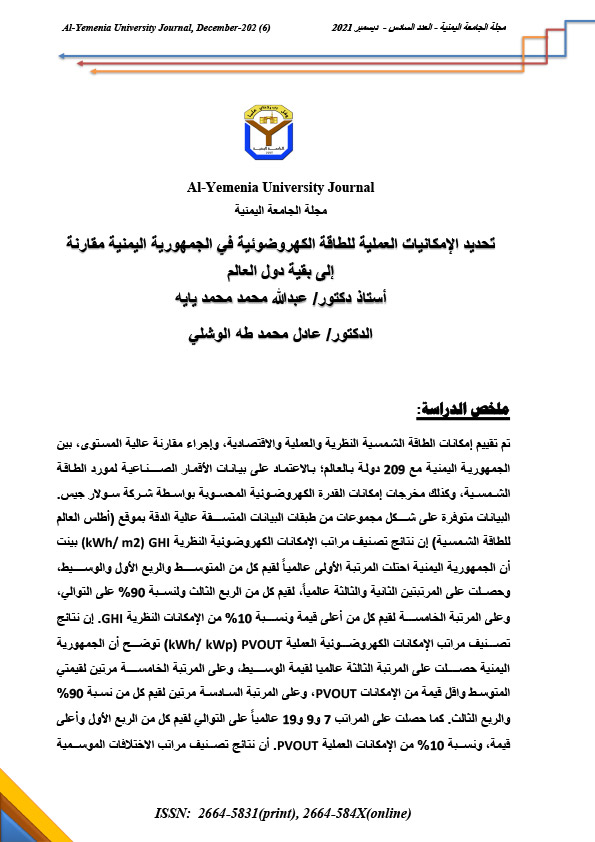Determining the practical potential of photovoltaic energy in the Republic of Yemen compared to the rest of the world.
Abstract
The theoretical, practical and economic potential of solar energy was evaluated, and a high-level comparison was made between the Republic of Yemen and 209 countries in the world; based on satellite data for solar energy resources, as well as the outputs of photovoltaic capacity potential calculated by SolarGIS. The data are available in the form of sets of consistent high-resolution data layers on the (World Solar Atlas) website. The results of the classification of the theoretical photovoltaic potential levels GHI (kWh/ m2) showed that the Republic of Yemen ranked first globally for the values of the average, first quarter and median, and ranked second and third globally for the values of the third quarter and 90% respectively, and ranked fifth for the values of the highest value and 10% of the theoretical potential GHI. The results of the classification of the practical photovoltaic potentials PVOUT (kWh/kWp) ranks show that the Republic of Yemen ranked third globally for the median value, fifth twice for the average and lowest PVOUT values, and sixth twice for the 90% and third quarter values. It also ranked 7th, 9th and 19th globally respectively for the first quarter and highest value, and 10% of the practical potential PVOUT. The results of the classification of the seasonal differences ranks for the monthly practical potentials PVOUT (kWh/kWp) show that the Republic of Yemen ranked second five times for the average practical potential PVOUT for the months of February, March, October, November and December. It also ranked third and sixth for the average PVOUT for the months of January and April respectively. While it ranked 33rd, 42nd, 89th, 96th and 124th for the average PVOUT for the months of May, September, June, August and July respectively. The results of the evaluation of the social and economic indicators related to photovoltaic energy show that the Republic of Yemen ranked 12th and 106th globally for the average indicators of photovoltaic economic potential ($/kWh) and photovoltaic seasonality (kWh/kWp) respectively. While the Republic of Yemen ranked 13th out of (135 countries), 58th out of (189), 112th (out of 188), 146th (out of 198) and 123rd (out of 137) for the average indicators of the equivalent area of photovoltaic (%), the cumulative installed photovoltaic capacity (MW), the cumulative installed photovoltaic capacity (w/Capita), access to electricity (%) and the consumption of electrical power (kWh/Capita) respectively. The results of the distribution of practical photovoltaic potential (PVOUT) worldwide show that the difference between the two countries with the highest average (Namibia) and the lowest average (Ireland) is slightly more than 2. It also shows that 93% of the world's population lives in countries with an average daily practical potential of 3-5 kWh/ kWp, which is divided into three categories of practical potential worldwide. The top-ranked category includes 70 countries with 20% of the world's population and average PVOUT of more than 4.5 kWh/ kWp. This category includes the Middle East, North Africa and Sub-Saharan Africa, along with Afghanistan, Argentina, Australia, Chile, Iran, Mexico, Mongolia, Pakistan, Peru, and the Pacific and Atlantic island countries. The bottom-ranked category includes 30 countries with 9% of the world's population and average PVOUT of less than 3.5 kWh/ kWp. This category includes European countries (except Southern Europe), Ecuador and Japan. The mid-range category includes 105 countries, home to 71% of the world's population, and has an average PVOUT range of 3.5-4.5 kWh/kWp. This category includes five of the world's six most populous countries (China, India, the US, Indonesia, and Brazil) and 100 other countries (Canada, the rest of Latin America, Southern Europe, the Gulf of Guinea, and Central and Southeast Asia).



